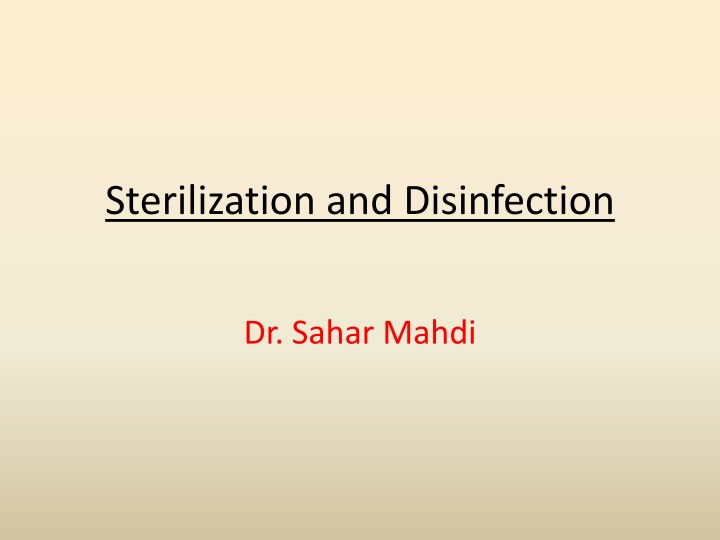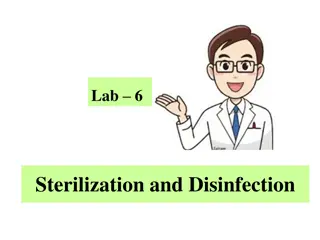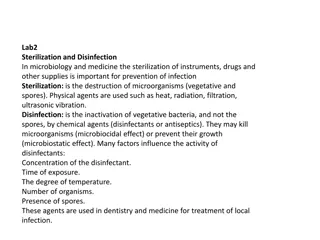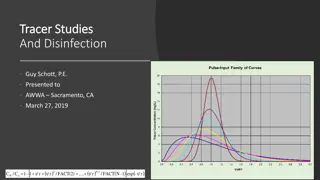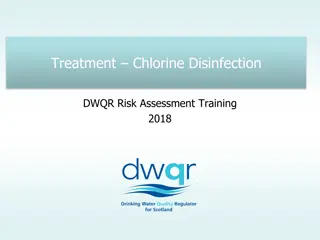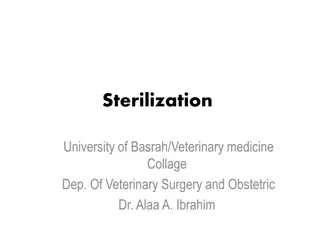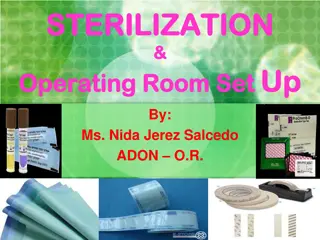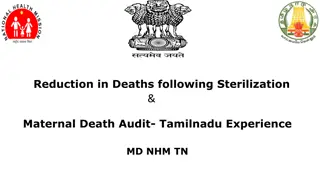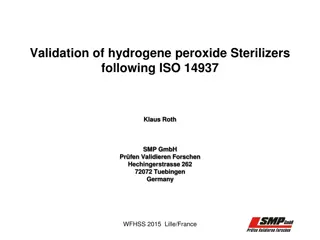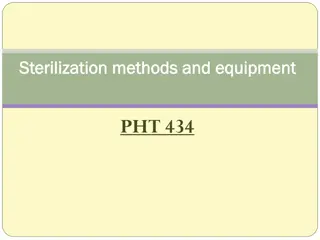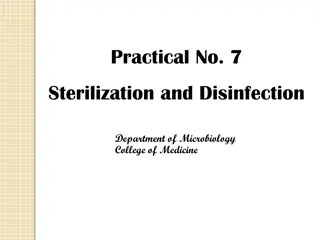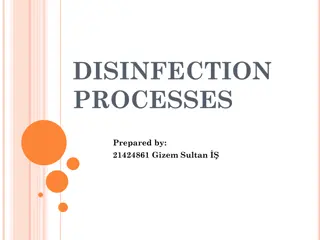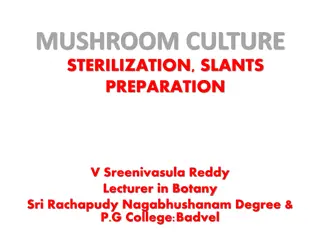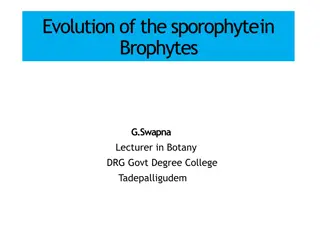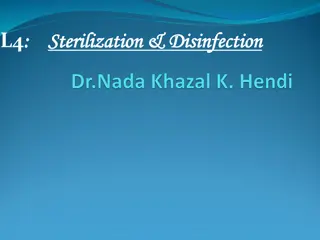Sterilization and Disinfection
Aseptic techniques play a crucial role in preventing contamination during surgeries, reducing the risk of nosocomial infections and improving patient outcomes. Understanding the difference between sterilization and disinfection is key to maintaining asepsis in medical settings.
Download Presentation

Please find below an Image/Link to download the presentation.
The content on the website is provided AS IS for your information and personal use only. It may not be sold, licensed, or shared on other websites without obtaining consent from the author.If you encounter any issues during the download, it is possible that the publisher has removed the file from their server.
You are allowed to download the files provided on this website for personal or commercial use, subject to the condition that they are used lawfully. All files are the property of their respective owners.
The content on the website is provided AS IS for your information and personal use only. It may not be sold, licensed, or shared on other websites without obtaining consent from the author.
E N D
Presentation Transcript
Sterilization and Disinfection Dr. Sahar Mahdi
Aseptic techniques to prevent contamination of surgical wounds. Prior to this development: Nosocomial infections ) caused death in 10% of surgeries ( ) Up to 25 % mothers delivering in hospitals died due to infection. Sterilization The process of freeing an article from microorganisms including their spores. Disinfection: Reducing the number of pathogenic microorganisms to the point where they no longer cause diseases. Bacteriostatic Agent: An agent that inhibits the growth of bacteria but dose not necessarily kill them. Sepsis: Comes from Greek for decay or putrid. Indicates bacterial contamination (
Asepsis: Absence of significant contamination. Aseptic techniques are used to prevent contamination of surgical instruments, medical personnel and the patient during surgery. Bactericide or Bactericidal: An agent that kill bacteria , most do not kill endospores. Sporicide: An agent that kills spores.
Uses to sterilize forceps, Scissors, Scalpels, Swabs. Pharmaceuticals products like liquid paraffin, dusting power, fats and grease. Incineration This is an excellent method of destroying materials such as contamination cloth, animal carcasses and pathological materials.
1- Hot air oven 2- Flaming Inoculation loop or wire the tip of forceps and spatulas are held in a Bunsen flame till they are red hot .
B- Moist heat sterilization kills microorganisms by coagulating their proteins. 1- Pasteurization Process of killing of pathogens in the milk but dose not sterilize it . Milk is heated at 63 C for 30 mins. (holder method) At 72 C for 15-20 sec. rapid cooling to 13 C (flash process).
Moist heat sterilization is carried out with following methods 1- Temperature below 100 C " pasteurization" . 2- Temperature at 100 C boiling. 3- Steam at atmospheric pressure " KOCH\ ARNOLD'S STEAMER 4- Steam under pressure "Autoclave Hot water bath - To inactivate non sporing bacteria for the preparation of vaccines Special vaccine bath at 60 C for one hour is used. - Serum or body fluid containing - Coagulable proteins can be sterilized by heating for 1 hr. at 56 C in water bath for several successive days.
Temperature at 100C Boiling: - kills vegetative forms of bacterial pathogens. Hepatitis virus; can survive up to 30 minutes of boiling Endospores ; can survive up to 20 hours or more of boiling. Steam at atmospheric pressure - Steam is generated using a steamer (Koch\ Arnold) - consists of a tin cabinet - has a conical lid to enable the drainage of condensed steam - perforated tray above ensures materials are surrounded by steam. - for routine sterilization exposure of 90 min is used. - for media containing sugar and gelatin exposure of 100 C for 20 min for 3 successive days is used. the process is termed as - Tyndallisation\ intermittent sterilization( (
Steam under pressure - Autoclave - is a pressure chamber used to carry out industrial processes requiring elevated temperature and pressure - Autoclave consists of a vertical or a horizontal cylinder. - Autoclaves are used in medical applications to perform sterilization and in the chemical industry to cure coatings and vulcanize rubber and for hydrothermal synthesis -Many autoclaves are used to sterilize equipment and supplies by subjecting them to high-pressure saturated steam at 121 C for around 15 20 minutes depending on the contents - The autoclave was invented by Charles Chamberlandin 1879 - Typical loads include laboratory glassware, other equipment and waste, surgical instruments, and medical waste.
Alcohols - Ethanol, isopropyl alcohol are frequently used. - No action on spores - Concentration recommended 60-90% in water Uses: - Disinfection of clinical thermometer. - Disinfection of skin- venupuncture. chemical agents chemical agent act by: - protein coagulation -disruption of the cell membrane -removal of sulphydryl groups - substrate competition
Aldehydes - formaldehyde is bactericidal , sporicidal and has a lethal effect on viruses formaldehyde uses: - to preserve anatomical specimens -destroying Anthrax spores in hair and wool - 10% formalin + 0.5% Sodium tetra borate ia used to sterilize metal instruments Dyes two groups of dyes are used: 1- Aniline dyes - are brilliant green , malachite green and crystal violet - Active against Gram positive bacteria - no activity against tubercle bacilli. 2- Acridine dyes - Acridine dyes are orange in colour - Effective against Gram positive than Gram negative - important dyes are proflavine, Acriflavine and Euflavine.
Halogens - Iodine in aqueous and alcohol solution has been used widely as a skin disinfectant - Actively bactericidal with moderate against spores - Chlorine and its compounds have been used as disinfectants in water supplies and swimming pools. Uses - Specially used for sterilizing heart-lung machines , respirators , sutures , dental equipments, books and clothing - used to sterilize Glass , metal and paper surfaces, plastics some food and tobacco
Gases Ethylene oxide -Colorless, highly penetrating gas with a sweet ethereal smell. - Effective against all type of microorganisms including viruses and spores. Formaldehyde gas - Widely employed for fumigation of operation theaters and other rooms Sterilization by filtration Filtration helps to remove bacteria from heat labile liquids such as sera and solutions of sugars and antibiotics.
The following filters are used : 1- Candle filters 2- Asbestos filters 3- Sintered glass filters 4- Membrane filters Candle filters - widely used for purification of water . There are two types: a- Unglazed ceramic filter- chamberland filter b- Diatomaceous earth filters- Berkefeld filters
Asbestos filter - disposable single use discs - high adsorbing tendency -carcinogenic ex. Seitz filter
Sintered glass filter - prepared by heat fusing powered glass particles of graded size
Membrane filters - made of cellulose esters or other polymers uses: - water purification and analysis - sterilization sterility testing . - preparation of solution for parenteral use
Non- ionizing radiation - electromagnetic rays with longer wavelength. - Absorbed as heat. - Can be considered as hot air sterilization . - Used in rapid mass sterilization of prepacked syringes and catheters ex: UV rays Radiation Two types of radiations are used 1-Non- ionizing 2- Ionizing
Ionizing radiations - X- rays, gamma rays and cosmic rays - High penetrative power - No appreciable increase in the temperature- cold sterilization - Sterilize plastics Syringes , catheters, grease fabrics metal foils. Transonic and sonic vibration - bactericidal - microorganisms vary in their sensitivity hence no practical value in sterilization and disinfection
